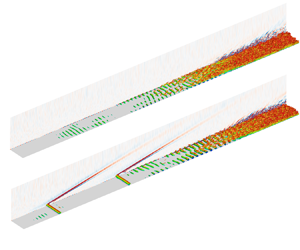Article contents
Instability and transition control by steady local blowing/suction in a hypersonic boundary layer
Published online by Cambridge University Press: 14 August 2024
Abstract

The efficacy of steady large-amplitude blowing/suction on instability and transition control for a hypersonic flat plate boundary layer with Mach number 5.86 is investigated systematically. The influence of the blowing/suction flux and amplitude on instability is examined through direct numerical simulation and resolvent analysis. When a relatively small flux is used, the two-dimensional instability critical frequency that distinguishes the promotion/suppression mode effect closely aligns with the synchronisation frequency. For the oblique wave, as the spanwise wavenumber increases, the suppression effects would become weaker and the mode suppression bandwidth diminishes/increases in general in the blowing/suction control. Increasing the blowing/suction flux can effectively broaden the frequency bandwidth of disturbance suppression. The influence of amplitude on disturbance suppression is weak in a scenario of constant flux. To gain a deeper insight into disturbance suppression mechanism, momentum potential theory (MPT) and kinetic energy budget analysis are further employed in analysing disturbance evolution with and without control. When the disturbance is suppressed, the blowing induces the transport of certain acoustic components along the compression wave out of the boundary layer, whereas the suction does not. The velocity fluctuations are derived from the momentum fluctuations of the MPT. Compared with the momentum fluctuations, the evolutions indicated by each component's velocity fluctuations greatly facilitate the investigations of the acoustic nature of the second mode. The rapid variation of disturbance amplitude near the blowing is caused by the oscillations of the acoustic component and phase speed differences between vortical and thermal components. Kinetic energy budget analysis is performed to address the non-parallel effect of the boundary layer introduced by blowing/suction, which tends to suppress disturbances near the blowing. Moreover, viscous effects leading to energy dissipation are identified to be stronger in regions where the boundary layer is rapidly thickening. Finally, it is demonstrated that a flat plate boundary layer transition triggered by a random disturbance can be delayed by a blowing/suction combination control. The resolvent analysis further demonstrates that disturbances with frequencies that dominate the early transition stage are dampened in the controlled base flow.
Information
- Type
- JFM Papers
- Information
- Copyright
- © The Author(s), 2024. Published by Cambridge University Press
References
- 9
- Cited by


